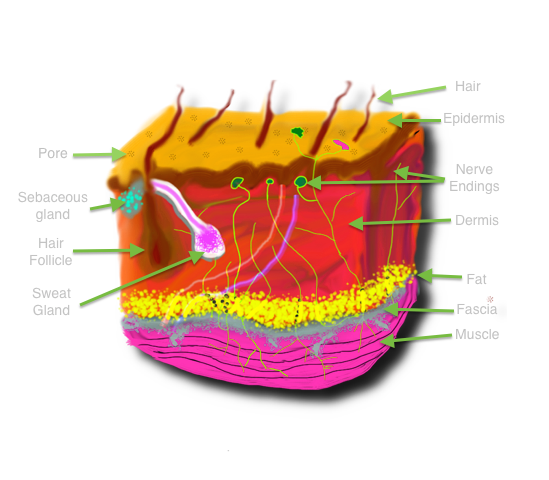Skin: The Largest Sensory Organ
(Workbook Page 20)
We can determine the various and magnificent properties of our skin and describe just how powerful it is as our largest sensory organ when we find ourselves using expressions like, ‘That makes my skin crawl’, ‘I’ve got you under my skin’ or ‘he has a thick skin’. Our skin is not only a sensory organ, it is the largest organ of our body. It is easy to understand why touch has been called the most important of the senses when we think of the magnitude of the skin. In addition to allowing us to sense touch, the skin protects us from external forces, and acts as an interface between our outside world and the layers of connective tissue that lie beneath it. It regulates our temperature via heat exchange and perspiration, controls fluid and hydration status, keeps out infection and mounts inflammatory and healing responses. Read the text beneath the graphic on page 20 of the Neuroplastic Transformation workbook to understand in greater detail the richness and complexity of the skin, how it becomes involved in persistent pain and strategies for resolving that pain.
Our skin is the connection between the outside world and our brains. It is the outermost layer of the connective tissue network that tracks down from the skin to the layers and structures below. The connective tissues include the skin, subcutaneous fat, superficial fascia, muscle, ligaments, tendons, organs, bones, peripheral nerves and blood vessels. Fascia provides a scaffolding for our organs and becomes the capsules around them. It lines the cavities and separates compartments. It is continuous with the membranes around the spinal nerves, spinal cord and brain. It ensures that all function is supported and everything works as it should.
We identify the connective tissue structures discreetly in anatomic dissections and for the purposes of teaching, however, they are really a continuum of structures. The dramatic and elegant connection between the nervous system and the connective tissue system lies in and just under the skin where innumerable receptors are imbedded. These receptors, responsible for the sense of touch, vary according to location and function of the bodily area in which they reside. They discern pressure, temperature, position, vibration and pain. They receive and transmit their information to the spinal cord where other neurons then transmit signals to the somatosensory cortex in the parietal lobe of the brain. Here, those signals are perceived as sensations. The skin, the connective tissue structures that lie beneath it and the brain are in constant communication with each other, adjusting to even the most subtle changes.

